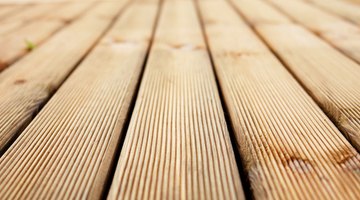Chlorine Bleach Vs. Oxygen Bleach Deck Cleaning
Table of Contents
Bleach is one recommended cleaning solution for wood decks. However, there are two types of bleach that garner similar results with different processes and advantages. Choose either chlorine bleach or oxygen bleach, depending on your needs and on your deck.

Advantages of Oxygen Bleach
Oxygen bleach is a non-toxic and natural chemical cleaner. The cleaner will not damage plants or animals. Another major advantage to using oxygen bleach is that it is gentler than chlorine bleach. It will not change the color or texture of the wood deck, it will not corrode nails on the surface of the deck. Chlorine bleach will lighten the wood and can accelerate the rate at which the nails in the wood wear down.
Advantages of Chlorine Bleach
Chlorine bleach is stronger than oxygen bleach. This means you do not need to scrub the dirt and debris off of the deck as much as you do when you use oxygen bleach. This is because chlorine bleach does a better job at loosening the dirt and debris’ hold on the wood deck.
Using Chlorine Bleach
To use chlorine bleach, Mix 10 cups bleach with 2 gallons water. Apply it to the deck with a sponge so that the entire deck is completely covered. Let it sit for 10 minutes before scrubbing the dirt and debris off. Rinse the deck with clear water and let it dry completely.
Using Oxygen Bleach
To use oxygen bleach, mix 2 lbs. of the powdered oxygen bleach with 5 gallon water until the powdered bleach is completely dissolved. Immediately apply the solution to the wood deck and let it sit for 20 minutes. The solution will bubble during this time. Scrub the wood until you remove the dirt. Rinse the deck with water and let it air dry.
Safety
Chlorine bleach is a highly toxic solution that will disinfect your deck, but that can irritate your skin, eyes and lungs. This is especially a problem if you have asthma or another respiratory issue. Chlorine bleach will also kill plants if the deck-cleaning solution runs off onto them. Oxygen bleach is non-toxic for people and plants. You need to wear gloves when using it to protect your skin from drying out, but it will not harm plants.
References
Writer Bio
Kaye Wagner has been working in the fields of journalism and public relations since 2006 and is a recipient of a National Hearst Award. She is particularly interested in home-and-garden projects, as well as beauty and fashion writing. An avid traveler, she also writes travel reviews and guides. Wagner earned a Bachelor of Arts in journalism from Brigham Young University.
Photo Credits
- Deck de madeira image by CarlosNeto from Fotolia.com
- Deck de madeira image by CarlosNeto from Fotolia.com
More Articles



